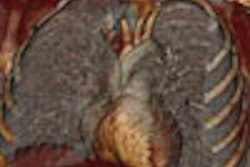CHICAGO - A three-hour-long, noninvasive treatment for uterine fibroids can eliminate symptoms such as bleeding, bulkiness, and pain for 12 months in 85.7% of women treated, Harvard researchers reported today at the 2005 RSNA conference.
MR-guided focused ultrasound (MRgFUS) treatments using the ExAblate 2000 from InSightec of Haifa, Israel, significantly reduced symptoms at three, nine, and 12 months said Dr. Fiona M. Fennessy, Ph.D., an instructor of radiology at Harvard Medical School and a staff radiologist at Brigham and Women's Hospital in Boston.
At baseline the average score on the uterine fibroid quality of life (UFQOL) questionnaire was 60, but after treatment with the expanded protocol scores were reduced to 30 or less, Fennessy said. On the UFQOL a score of 100 indicates extreme, disabling symptoms. "Healthy, asymptomatic women would score about 22," she said.
The original MRgFUS protocol limited treatment time to two hours and fibroid volume to 100 cc. The expanded protocol increased treatment time to three hours and fibroid volume to 150 cc. "We improved results with the expanded protocol," Fennessy said. "Under the original protocol, 75.8% of women had significantly improved symptoms at 12 months. We added about 10% to that result with the expanded protocol."
The ExAblate 2000 system, which is currently the only FDA-approved device for MRgFUS of uterine fibroids, includes an ultrasound transducer in the MR table. Before treatment, the women undergo pelvic MR imaging to confirm that the fibroid can be treated without affecting the bowel or other surrounding anatomy.
The patient is given conscious sedation prior to treatment, then lies facedown on the table so that "the fibroid is positioned above the transducer," Fennessy said. Women are told to lie still for each sonification, she added.
Some women experience mild cramping during the sonification, she said, but in general the procedure is relatively pain-free aside from the discomfort of lying facedown on an MR table for three hours.
The treatment does not entirely remove the fibroid, but "sonification does kill the bulk of the tissue," Fennessy said. Complete removal would require surgery, she explained.
Asked if MRgFUS might be combined with uterine fibroid embolization, Fennessy declined to speculate about that possibility.
By M. M. PennellAuntMinnie.com contributing writer
November 30, 2005
Related Reading
InSightec partners with ACRIN, November 22, 2005
MRI-guided ultrasound therapy relieves fibroid symptoms, December 14, 2004
U.S. advisers back new ultrasound fibroid therapy, June 4, 2004
Copyright © 2005 AuntMinnie.com



















